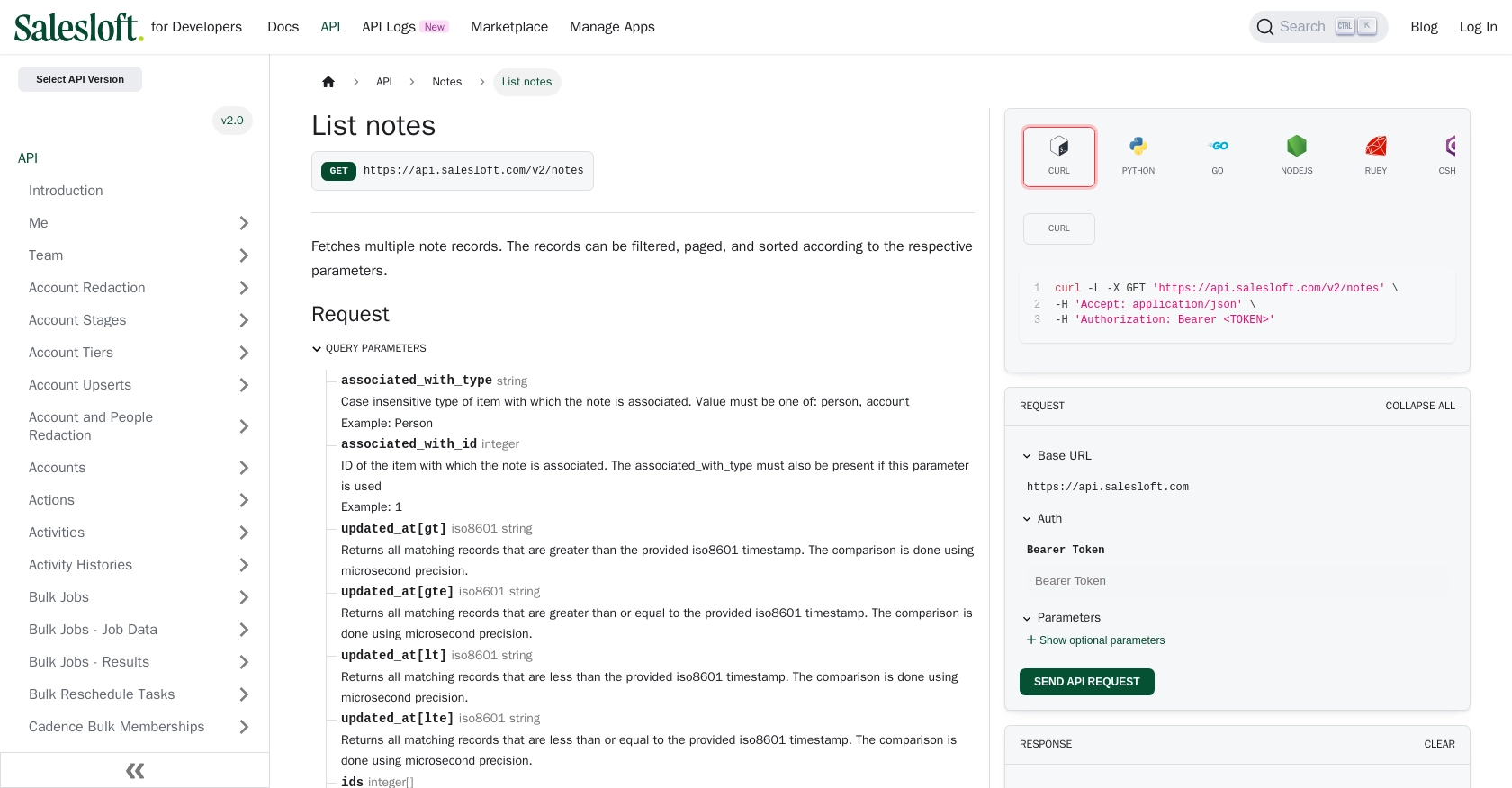How to Get Notes with the Salesloft API in Python

Introduction to Salesloft API Integration
Salesloft is a powerful sales engagement platform designed to enhance the efficiency and effectiveness of sales teams. It offers a suite of tools that streamline communication, automate repetitive tasks, and provide valuable insights into sales activities.
Integrating with the Salesloft API allows developers to access and manage sales data programmatically. For example, retrieving notes associated with sales activities can help in analyzing customer interactions and improving sales strategies. By using the Salesloft API, developers can automate the extraction of notes, enabling seamless integration with other business tools and enhancing data-driven decision-making.
Setting Up Your Salesloft Test Account for API Integration
Before you can start interacting with the Salesloft API, you need to set up a test account. This will allow you to safely experiment with API calls without affecting live data. Salesloft provides a sandbox environment where developers can test integrations and ensure everything works as expected.
Creating a Salesloft Sandbox Account
If you don't already have a Salesloft account, you can sign up for a free trial on the Salesloft website. This will give you access to the platform's features and allow you to create a sandbox environment for testing.
- Visit the Salesloft website and click on the "Free Trial" button.
- Fill out the registration form with your details and submit it.
- Once your account is created, log in to access the Salesloft dashboard.
Creating an OAuth App in Salesloft
To interact with the Salesloft API, you'll need to create an OAuth app. This will provide you with the necessary credentials to authenticate API requests.
- Navigate to Your Applications in the Salesloft dashboard.
- Click on OAuth Applications and then Create New.
- Fill in the required fields, such as the application name and description.
- After saving, you will receive your Client ID and Client Secret. Make sure to store these securely as they are needed for authentication.
Obtaining Authorization Code and Access Tokens
With your OAuth app set up, you can now obtain the authorization code and access tokens required to make API calls.
- Direct your browser to the following URL, replacing
YOUR_CLIENT_IDandYOUR_REDIRECT_URIwith your app's details: - Authorize the application when prompted. You will be redirected to your specified URI with a code parameter.
- Exchange this code for an access token by making a POST request to the token endpoint:
- Store the returned access_token and refresh_token for future API requests.
https://accounts.salesloft.com/oauth/authorize?client_id=YOUR_CLIENT_ID&redirect_uri=YOUR_REDIRECT_URI&response_type=code
POST https://accounts.salesloft.com/oauth/token
{
"client_id": "YOUR_CLIENT_ID",
"client_secret": "YOUR_CLIENT_SECRET",
"code": "YOUR_AUTHORIZATION_CODE",
"grant_type": "authorization_code",
"redirect_uri": "YOUR_REDIRECT_URI"
}
With your Salesloft test account and OAuth app configured, you're now ready to start making API calls to retrieve notes and other sales data programmatically.

sbb-itb-96038d7
Making API Calls to Retrieve Notes from Salesloft Using Python
To interact with the Salesloft API and retrieve notes, you'll need to use Python, a versatile programming language known for its simplicity and readability. This section will guide you through the process of making API calls to fetch notes from Salesloft.
Setting Up Your Python Environment for Salesloft API Integration
Before you begin, ensure you have Python installed on your machine. This tutorial uses Python 3.11.1. Additionally, you'll need to install the requests library, which simplifies making HTTP requests in Python.
pip install requests
Writing Python Code to Fetch Notes from Salesloft
Once your environment is set up, you can write a Python script to retrieve notes from the Salesloft API. Create a file named get_salesloft_notes.py and add the following code:
import requests
# Define the API endpoint and headers
endpoint = "https://api.salesloft.com/v2/notes"
headers = {
"Authorization": "Bearer YOUR_ACCESS_TOKEN",
"Accept": "application/json"
}
# Make a GET request to the Salesloft API
response = requests.get(endpoint, headers=headers)
# Check if the request was successful
if response.status_code == 200:
notes = response.json()["data"]
for note in notes:
print(f"Note ID: {note['id']}, Content: {note['content']}")
else:
print(f"Failed to retrieve notes. Status code: {response.status_code}")
Replace YOUR_ACCESS_TOKEN with the access token obtained during the OAuth authentication process. This script sends a GET request to the Salesloft API to fetch notes and prints the note ID and content if the request is successful.
Verifying Successful API Requests in Salesloft Sandbox
After running the script, verify the retrieved notes by checking the Salesloft sandbox environment. Ensure the notes displayed in your terminal match the data in your sandbox account.
Handling Errors and Understanding Salesloft API Error Codes
It's crucial to handle potential errors when making API requests. The Salesloft API may return various error codes, such as 403 for forbidden access or 404 for not found. Ensure your application gracefully handles these errors by checking the response status code and implementing appropriate error messages.
For more detailed information on error handling, refer to the Salesloft API documentation.

Conclusion and Best Practices for Salesloft API Integration
Integrating with the Salesloft API using Python provides a powerful way to automate and enhance your sales processes. By retrieving notes and other sales data programmatically, you can streamline workflows and make data-driven decisions more efficiently.
Best Practices for Secure and Efficient Salesloft API Use
- Secure Storage of Credentials: Always store your OAuth credentials, such as the client ID, client secret, and access tokens, securely. Consider using environment variables or secure vaults to protect sensitive information.
- Handling Rate Limits: Be mindful of the Salesloft API rate limits, which are set at 600 cost per minute. Implement logic to handle rate limit responses gracefully and consider using a backoff strategy to retry requests when limits are reached. For more details, refer to the Salesloft API rate limits documentation.
- Data Transformation and Standardization: When integrating data from Salesloft with other systems, ensure that data fields are transformed and standardized to maintain consistency across platforms.
Enhancing Integration Capabilities with Endgrate
While building integrations with the Salesloft API can be rewarding, it can also be time-consuming and complex. Endgrate offers a solution by providing a unified API endpoint that connects to multiple platforms, including Salesloft. This allows you to build once for each use case and streamline your integration processes.
By leveraging Endgrate, you can save time and resources, allowing your team to focus on core product development while ensuring a seamless integration experience for your customers. Explore how Endgrate can simplify your integration needs by visiting Endgrate.
Read More
- https://endgrate.com/provider/salesloft
- https://developers.salesloft.com/docs/platform/api-basics/oauth-authentication/
- https://developers.salesloft.com/docs/platform/api-basics/request-response-format/
- https://developers.salesloft.com/docs/platform/api-basics/filtering-paging-sorting/
- https://developers.salesloft.com/docs/platform/api-basics/rate-limits/
- https://developers.salesloft.com/docs/api/notes-index/
Ready to get started?
